Hiking Trail Hieroglyphics
Copyright 2004 by Michael Brochstein
Have you ever tried to navigate in a foreign city where the signs are in a language you do not understand and certain navigational symbols seem like hieroglyphics? I certainly have. To some people, the markings that indicate the path of a hiking trail are similarly confusing. With just a few tidbits of trail knowledge, the markings along a trail will be easy to understand.
Most hiking trails in the New York City area are generally marked in a similar manner and this article will concentrate on them. Each trail has a marking, also known as a “blaze”, that is assigned to indicate the path of that particular trail. The blaze is usually painted onto tree’s, rocks, and/or other objects in places that can easily be seen by hikers.
Painted blazes come in various shapes and sizes. The most popular two shapes are rectangles and circles. The Appalachian Trail that runs from Georgia to Maine uses a white colored blaze that is painted in the shape of a vertical rectangle typically about two inches wide and four or so inches tall. Other trails may be marked with a solid colored circle (i.e. red) inside a white border, sort of like the inside of a bull’s-eye. The inside color (i.e. red) would be considered the color of the trail’s markings. Other trail’s blazes may painted in the shape of triangles, horizontal rectangles, crosses, and other shapes.
At different points along the trail blazes will be painted one, two or three at a time. At the beginning and end of a trail three blazes will be painted together in the configuration of a triangle indicating that you are at a trail’s beginning or end points.
Most commonly, trail blazes will be seen one at a time. When a single blaze is seen along a trail this indicates that the trail generally goes straight ahead. On a hiking trail or woods road, the trail may not go exactly straight ahead in a strict geometric manner but a single blaze generally indicates that the trail goes straight ahead using your common sense as to what straight ahead would indicate in that location.
Trails have turn signals and when two blazes are painted together, one above the other, a turn or bend in the trail is indicated. The upper blaze will always be painted offset (not directly above) to the lower blaze. If the upper blaze is offset to the right then a right turn is indicated in the trail ahead (ditto for left). It is not that there will be an intersection between the trail you are on and another trail (although there could be) in a city street fashion, just that the trail will curve in some manner rightward (or leftward). Common sense is called for in interpreting trail markings.
Well marked trails are blazed for hikers going in both directions. A tree may have two blazes painted on a tree, one on each of two different sides of the tree. Similarly it may have four blazes with one pair of blazes painted on each of two different sides of a tree or rock. If you come across a nonsensical conglomeration of blazes then you may be seeing blazes for people not just going in the direction you are heading, but also seeing blaze(s) meant for those heading in the opposite direction.
There are places in the New York City area where different trails with the same color blazes intersect. Careful use of a trail map (and common sense) may be needed to figure out which markings are for the trail that you wish to be on.
Another type of trail marker is a “cairn”. A cairn is basically a pile of rocks. In areas where a painted blaze is not practical or desirable, one or more cairns may be used.
In other places in the United States and elsewhere trail blazes can look very different. In Israel a blaze can be a set of three parallel painted lines as much as a foot long. The outside two may be white and the inside may be another color with this middle color indicating the trail’s trail blaze color with the shape of the three lines roughly indicating the path of the trail ahead.
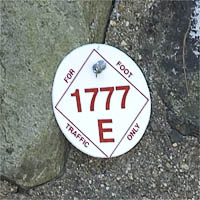 |
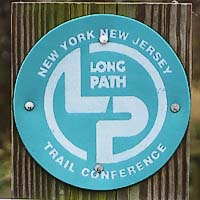 |
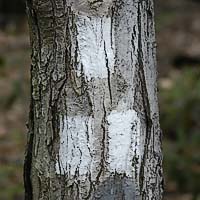 |
||
| Marker for 1777E Trail. | Marker for Long Path. | Beginning of a white blazed trail. | ||
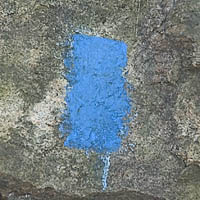 |
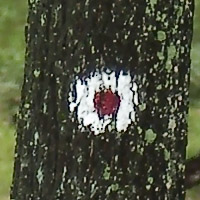 |
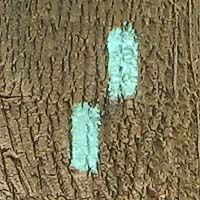 |
||
| A blue blaze. |
A red blaze (inside a white circle). |
Right turn. | ||
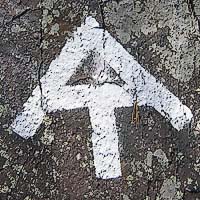 |
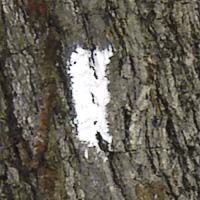 |
|||
|
Appalachian Trail. |
White blaze (this one for the Appalachian Trail). |
Comments: Michael_Brochstein@MABsystems.com
WARNING/DISCLAIMER: Outdoor activities can be dangerous and the information furnished on this website may contain errors!
Last revision: November 21, 2004